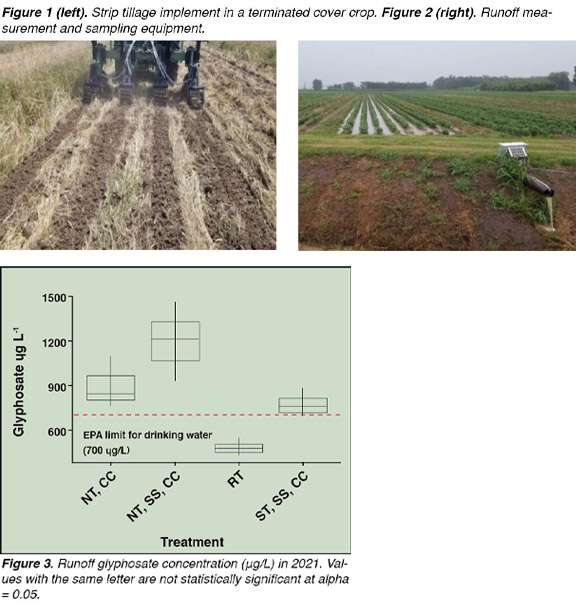Research Project
Strip Tillage and Cover Cropping Work Well When Transitioning to Conservation Systems in Mid-South Cotton
Investigators: Carson Roberts, Drew Gholson, Martin Locke, Dave Spencer, Whitney Crow, Brian Pieralisi
Funding Agency: Cotton Incorporated under project 21-863
Date: 2021
Project Summary
Introduction
Clean, warm, moist, and uncompacted seedbeds are often the best conditions for uniform, vigorous cotton seedling growth. Transitioning to conservation systems like no-till and cover cropping may change seedbed conditions causing reductions in yield. However, producers in other areas have adopted conservation cropping practices and experienced reduced runoff, reduced erosion, saved fuel and labor, and reduced irrigation water use. In recent years, these benefits have attracted some producers in the Mid-South to conservation practices despite the risk of reduced yield. However, few studies in the Mid-South have addressed the potential trade offs of conservation cotton production while exploring methods that improve soil and seedbed conditions. This study was developed to investigate how conservation tillage and cover crop systems influence lint yield and irrigation water use efficiency. It is hypothesized that water use can be reduced, and yield can be maintained or improved under conservation systems in the Mid-South.
Materials and Methods
A study is being conducted in Stoneville, MS, from 2021 to 2023 on a Dubbs silt loam (fine-silty, mixed, active, thermic Typic Hapludalfs). Study treatments include reduced tillage with subsoiling (RT), strip tillage (ST), strip tillage with cover crops (ST,CC), strip tillage with cover crops and subsoiling (ST,CC,SS), no tillage (NT), no tillage with cover crops (NT,CC), and no tillage with cover crops and minimal surface disturbance subsoiling (NT,CC,SS). This study is organized as a randomized complete block design with three replications. Plots consist of eight 40” rows that are 500’ in length. Cover crop treatments were terminated using 44 oz/ac glyphosate two weeks prior to planting. After termination, ST plots were tilled using a strip tillage implement (Figure 1). The variety Deltapine® 2012 B3XF was planted, and routine fertility, pesticide, and plant growth regulator applications were made. Watermark® soil moisture sensors were installed, irrigation was triggered at 90 kPa, and runoff was monitored (Figure 2). Data were analyzed in R studio using the lmer function in the lme4 package, and means were separated using unrestricted LSD at alpha = 0.05. Excessive rainfall occurred during the 2021 growing season. This resulted in the irrigation of only one RT plot after reaching the -90 kPa irrigation trigger, so no assumptions were made regarding irrigation water use efficiency in 2021. Lint yields were greatest where RT treatments were implemented and were comparable to ST,CC, SS and ST,CC treatments. The combination of strip tillage and cover crops resulted in an excellent seedbed. However, ST systems that lacked cover crops did not produce high yields. This is likely a product of poor soil tilth. The strip tillage operations without cover crops resulted in large chunks of soil and consequently a less than ideal seedbed for cotton establishment. All NT treatments reduced lint yield by at least 23%. Initial yield reductions when transitioning to NT have been reported by producers who have experimented with this practice. As is the case in this study, reduced yields during the first year of adoption are usually a result of poor stand establishment associated with the lack of experience in planting cotton in untilled soil with heavy residue. Preliminary data that investigates runoff water quality shows some differences in pollutant concentrations between the different treatments. Concentrations of glyphosate in the water from a burndown application of glyphosate are higher in NT,CC and NT,SS,CC than in the RT treatment (Figure 3). It is possible that these data can be misleading until coupled with runoff water quantity to evaluate total runoff pollutants on a volume basis. A volume measurement will offer more meaningful information about the quantity of pollutants entering the environment. Conclusion Cotton yield was not maintained under all conservations systems, but strip tillage with the addition of a cover crop is a system that shows promise. The irrigation aspect of this study needs to be studied further to reach any conclusions about the effectiveness of conservation systems to hold water. Sediment, nutrient, and total water runoff will be further analyzed to investigate potential volume differences in conservation systems. Since this is the first year of research, further investigation at this site is needed to determine the potential of these systems in the Mid-South.
Project Photos

- Crop Type:
- Cotton
- Topic:
- Tillage
- Technologies
- Cover Crops
Find Research
By Crop Type
By Topic
Contact NCAAR
General Information
Kaye Sullivan
vfs23@msstate.edu
662.390.8510
F:662.390.8501
Showcase Demo
Drew Gholson, Coordinator
drew.gholson@msstate.edu
662.390.8505
Himmy Lo
himmy.lo@msstate.edu
662.390.8509

